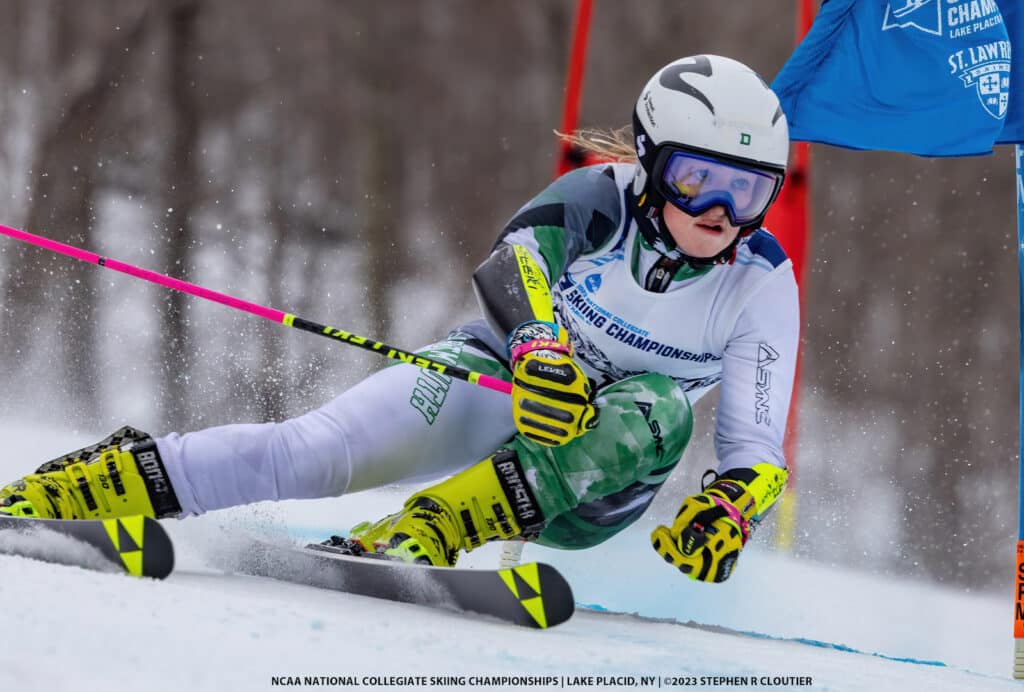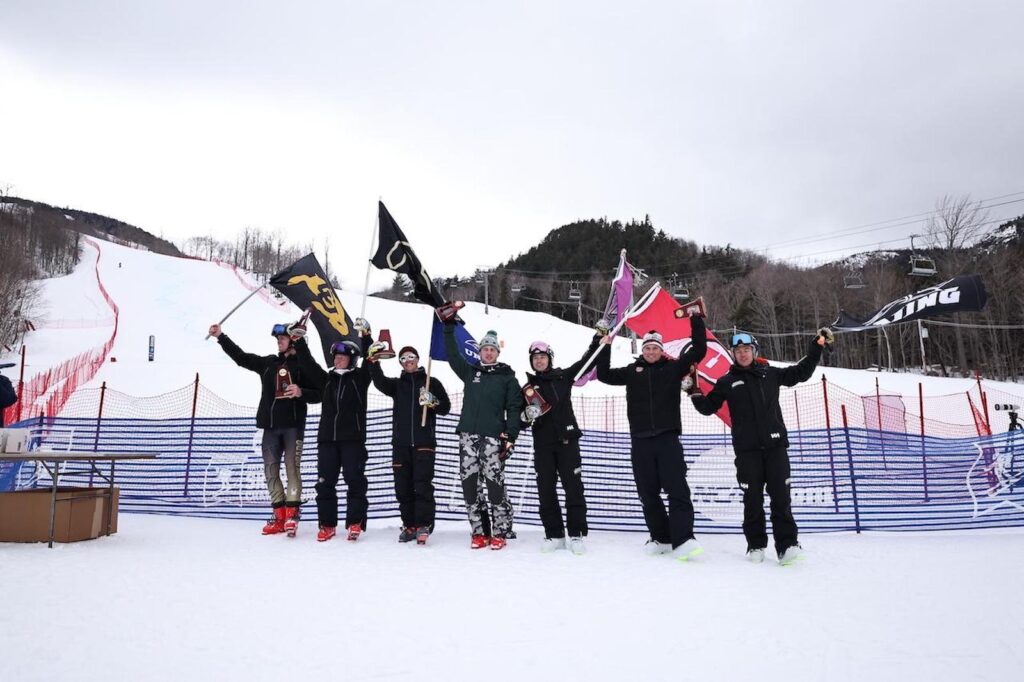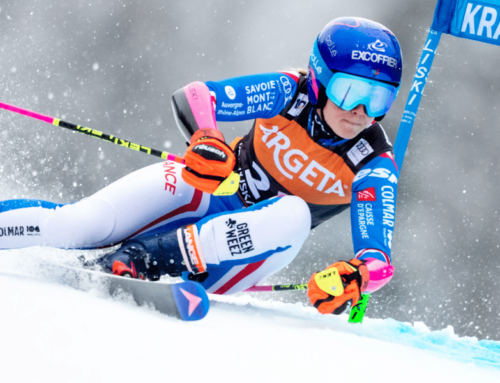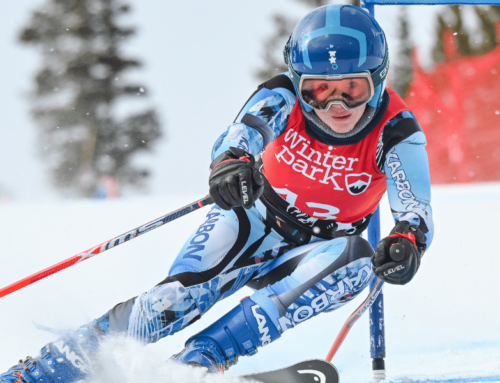So, you want to ski in the NCAA?
There is a discernable difference in ski racing when athletes advance from the sweet years of U16 racing to the uber-competitive years of FIS. Notably, there is more of everything—more days on snow, more races, more competition, more missed school, and more costs. There are also more questions, a common one being, “Where does this all lead?” Post-high school outcomes and options can seem cryptic outside the qualitative outcomes of building grit and resilience, learning to work hard toward a goal, finding a love of sport, and becoming a ripping skier.
Most parents and athletes see two visible paths, the US Ski Team and college racing. Yet as I stood on the side of the hill this season listening to parent conversations, I observed that the path to the latter, NCAA skiing in particular, needed to be better understood. The same questions surfaced every weekend. As a former NCAA skier and current college counselor, I had a broad understanding of the NCAA skiing, admissions, and recruiting landscape but didn’t know all the intricacies.
Like my fellow parents, I wondered: How many spots exist? What schools specifically have NCAA teams? How should a second-year U18 approach coaches and the application process with only one year of FIS? What is the difference between skiing for a D1, D2, or D3 team? What are the criteria; how good do you have to be?
But, unlike my fellow parents, it was my job to find the answers. I got curious and started researching.
I found an impressive report by Edie Thys Morgan written in 2019 called the Alpine Collegiate White Paper under the Collegiate tab of the USSS website. Then I called her and interviewed a handful of coaches from schools in the East and West. This is what I learned.
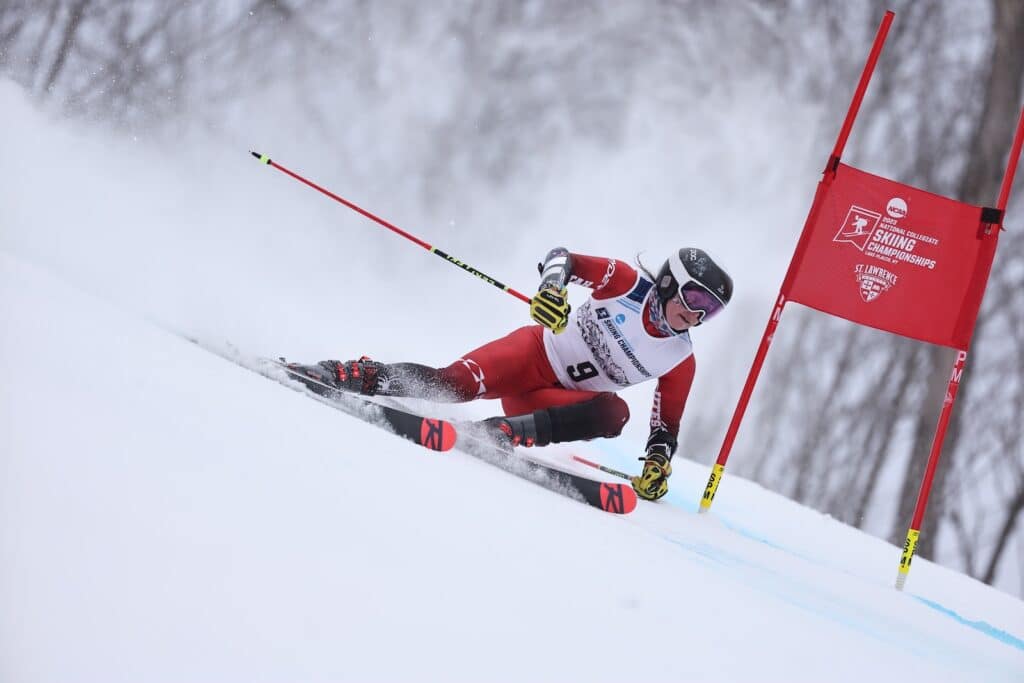
The Possibilities: Teams, Spots, and Scholarships
The Teams
Currently, 13 Eastern colleges have NCAA ski teams in the EISA (Eastern Intercollegiate Ski Association) and seven Western colleges with NCAA ski teams in the RMISA (Rocky Mountain Intercollegiate Ski Association). There is also the Central Collegiate Ski Association; however, the schools in that region with NCAA programs are Nordic only.
Schools with NCAA ski teams in the EISA include D1: Boston College, Dartmouth College, Harvard University, University of New Hampshire, University of Vermont; D2: St. Michael’s College; D3: Bates College, Colby College, Colby-Sawyer College, Middlebury College, Plymouth State University, St. Lawrence University, and Williams College.
Schools with NCAA ski teams in the RMISA include D1: University of Colorado, University of Denver, Montana State University, University of Utah, University of Nevada, Reno D2: University of Alaska, Anchorage, and Westminster College. Additionally, Colorado Mountain College in Steamboat Springs has a team that is an associate member of RMISA.
Academic and Athletic Scholarships
All schools, regardless of division, compete against each other in NCAA skiing as equals. However, each division has different NCAA rules and regulations around allocating scholarships and sanctioned training. Per NCAA regulation, Division 1 schools can give multi-year, cost-of-attendance scholarships, Division 2 schools can give partial scholarships, and Division 3 schools cannot give athletic scholarships.
The Division 1 schools that offer athletic scholarships have a strict allocation per NCAA regulations. There are 6.4 scholarships available for men and 7.0 for women to be distributed between both Nordic and alpine teams. The coaches determine how they are allocated regarding full and partial scholarships across the teams.
Schools must also follow the regulations of other consortiums to which they belong. For example, per Ivy League policy, Dartmouth and Harvard do not give merit scholarships; all tuition assistance is determined by need. Similarly, NESCAC (New England Small College Athletic Conference) schools like Bates, Colby, Williams, and Middlebury also base tuition assistance on determined need.
Some of these schools have significant subsidies for families that qualify. For example, Dartmouth has raised enough money to implement a “no loans” policy in which families do not have to borrow money to pay the gap between their EFC (Estimated Family Contribution) and the cost of tuition; thus, “no loans”. Additionally, Colby-Sawyer announced that all four-year undergraduate students in 2023-2024 will start with a tuition price of $17,500, cutting the 2022-2023 total published cost by 45%. Since 2011, colleges must make their costs transparent with online net price calculators per federal law.
Skiers can also benefit from less selective academic schools with generous academic awards. Schools such as the University of Denver, St. Lawrence University, St. Michael’s, and Westminster offer significant academic scholarships based on merit. Montana State University also offers generous, merit-based academic achievement awards and scholarships to athletes in states that are part of the Western Undergraduate Exchange or WUE. Schools are transparent about tuition, fees, financial aid, and merit scholarships.
“It’s great to have athletes who are high academic achievers and fast because you can get merit,” DU Coach Joonas Rasanen said. “The ski team has different scholarship options; we can stack that on top of the other aid DU offers. We can share the love across the team.”
Regardless of financial aid, all the costs associated with skiing, besides equipment, are generally covered by the university in NCAA skiing—no more coaching, club, training, or travel fees.
University of Colorado Coach Chad Wolk said, “Look at all programs. If you have a spot somewhere, you should take it. That college or university pays a substantial part of your skiing, so your tuition pays twice—academically and athletically. Too often, I see athletes and parents who are highly motivated on that elite program and dismiss other opportunities.”
The Spots
Each NCAA ski team typically carries anywhere from six to twelve athletes depending on the program’s funding and goals. Division 1 schools with athletic scholarships tend to carry smaller teams.
The 2022-2023 rosters from the EISA schools reveal 126 rostered females and 130 rostered men in the EISA. The largest EISA teams carried 14 women (Colby College) and 14 men (Boston College). The smallest carried four women (Harvard University) and five men (Harvard University).
The rosters from the RMISA schools reveal that there were 42 rostered females and 48 rostered men. All teams carried five to eight men and women on their rosters.
Teams with over 12 rostered athletes may have experienced a coaching change or restructuring or may still be in what coaches call the “COVID bubble,” referring to the abnormal distribution of athletes who deferred admissions while schools navigated the COVID pandemic.
College teams can enter up to six athletes per collegiate race, called College Carnivals in the East and FIS University Races in the West. The athletes with the top three team results score for each school. Athletes must qualify for the NCAA Championships individually, with only 17 available spots per region and a total field size of 34 for each gender.
“Team sizes vary,” said Peter Dodge, former Dartmouth coach. “Dartmouth has carried up to 12. In any given year, about ten different skiers will get into at least one college race. Over a four-year period, everyone on the varsity team will get a chance to race. Often first years might spend the whole season racing Regional FIS and/or USCSA FIS races before moving up to NCAA starting rosters. Most teams spread the NCAA starts around with the top skiers racing all the meets and the five and six spots more variable.”
The teams in the RMISA carry less athletes overall.
“It’s tight,” Rasanen said. “We try to carry six to eight athletes of each gender. That way, we travel with everyone. Everyone here is part of the team and valuable on and off the hill.”
All coaches pointed out that available team spots vary from year to year depending on the number of graduating seniors and the shifting needs of the team.
“It’s important to find your own path,” Rasanen said. “Look at the rosters and see if there are spots opening up when you’re thinking of going to college and consider if it’s the right time to go for you.”
The Criteria: Points, Grades, and Admission
Athletes and parents are eager to know what it takes to ski for each NCAA team and often want metrics associated with points and grades. Although guidelines around these metrics exist, they vary from school to school depending on how selective academic admissions are, how many spots are available for the given year, and how competitive the team is.
“We’ve had athletes graduate from Middlebury and move to the [national] team and World Cup success,” Middlebury Coach Stever Bartlett said. “There are a couple of schools and some Western schools that do this, but not every athlete wants that.”
Another factor for prospective NCAA skiers are the various age exceptions and criteria given in the different divisions that ultimately encourage delaying matriculation to college after high school graduation.
In Division 1 NCAA skiing (and ice hockey) athletes can delay the start of their eligibility for three years; the maximum eligibility age is 25-26 (depending on when their birthday falls). Consequently, athletes can start their NCAA athletic career at 21-22 and still have four years of eligibility. In comparison, NCAA tennis players can delay enrollment only six months after graduation, while athletes in all other sports are granted 12 months after high school graduation before their four-year NCAA eligibility clocks start ticking.
Division 3 has no age limitation or start date. The specific criteria around age eligibility for Division 2 is complicated, but the general rule is that athletes have ten semesters of eligibility from the time they start college. The age criteria across the divisions can grant eligibility for older skiers, sometimes in graduate school, to compete with undergraduates and for athletes who delayed matriculation to ski on national teams.
As a result, it makes it difficult for athletes to be competitive immediately after graduating from high school, as they will be competing for the same roster spots against athletes much older, stronger, and more experienced. It also raises the level of NCAA skiing and skiing in the US overall.
Dodge says, “Many would like to see the exception eliminated, with the eligibility clock starting one year after high school graduation, as in most other NCAA sports, and take younger skiers. However, given the rules, and to be competitive, it is more advantageous to take more mature athletes who have taken one or two PG years.”
Who is skiing for the schools
To find a baseline regarding the point profile necessary to ski at different schools, parents and athletes can look at the school’s roster and then look up the athletes’ points on their respective teams on the FIS app. They’ll find a wider point range between the teams in the EISA than in the RMISA. Evaluating prospective athletes solely on points gets tricky as the application deadlines for colleges and the timing of the ski season do not align well.
Both the school and the ski team need to accept the athlete for them to ski for a college. The traditional college application cycle has students contacting coaches during their junior year spring and summer and applying to colleges senior year fall, often after only one year of FIS racing for the younger seniors and two for the older ones. An athlete’s ski profile can change significantly throughout their senior-year season, and so can their chances of skiing NCAA.
“We’re going to delay the evaluation piece until an athlete’s senior year of school because it’s such a small sample year,” Wolk said. “Most athletes need that time. There is a lot to be said for keeping options open. It’s a difficult path to navigate.”
Other schools, like the University of Denver, have more flexibility with admissions later into the school year and even after standard admission deadlines. Although Rasanen likes to have his roster set for the following season by the spring series, he acknowledges it doesn’t always go that way and encourages athletes to stay in touch.
Given the structure of FIS skiing and the traditional college application timeline, the effect of the age exception inherent to NCAA skiing cannot be ignored. The reality is that some athletes will have to PG to make a competitive NCAA team. However, all coaches mentioned that performance is one way to get their attention. Put simply, beat their current athletes on the hill.
“We’re seeing kids getting second runs at Nor Ams and demonstrating success against good athletes,” Bartlett said. “If you’re in the mix, that’s great. It’s not all about going to Lutsen and scoring a 30.”
“We can’t guarantee and say if you have XX points, you’ll make the team,” Rasanen said, “because we’re developing athletes in a perfect world. That’s a testament to our program. Beat the people on the D1 teams, and you’ll have a chance of skiing D1.”
Coaches’ Final Words: Character and Culture
According to the coaches interviewed, student/athletes who want to ski NCAA not only need to meet the athletic and academic criteria specific to each school for admission but must be able to balance their obligations to both over their four years there.
Additionally, each coach stressed that they’re looking for student/athletes with character who match the school’s culture. College skiing is not club skiing; the coaches can choose who they want to work with. When asked what they’re looking for in their student/athletes, all coaches talked about character, team, maturity, leadership, and academics.
“We care who they [the athletes] are as people and what they have to offer outside of the ski racing world,” Rasanen said. “DU wants students who stand out on the score sheet and outside of the score sheet. We know most club coaches and pick up the phone.”
“Having a match in terms of culture, work ethic, and academics is incredibly important,” Wolk said. “They’re in school to advance their lives beyond ski racing. I walk into these facilities and think, if you’re not leaving here ready to conquer the world, that’s on you.”
“We want fast athletes who want to win,” Norden said, “but who also represent BC well in the classroom and community. We want to know their character. It’s my job as a coach to protect and nurture the culture of BC on and off the hill.”
Takeaways for High School Students Who Want to Ski NCAA
1. Goals and Timeline: Identify your personal academic and ski racing goals and a realistic timeline to reach them.
2. Research the ski part: Go to the colleges’ websites you are interested in. Look at their rosters. Note the number of upperclassmen on each team; that gives you an idea of potential open roster spots. Look up athletes’ points on the FIS app.
3. Research the academic part: Go to the college websites and research the criteria for the colleges you wish to apply to. Identify if the school requires standardized test scores or if it’s test optional. Identify the average GPA of accepted students and the average standardized test scores of accepted students (each school gives the score range of the middle 50% of accepted students, meaning 25% scored lower and 25% scored higher than that number). If the school is test-optional, ask what percent of accepted students submitted test scores.
4. Communicate: Let your college counselor and club ski coach know your goals.
5. Contact: Email college coaches and ask to meet with them when you visit schools. Stay in touch.
6. Do the work: Work hard on and off the hill. Be courteous to your coaches and teammates and follow your interests outside of ski racing.
7. Make a college application strategy: Identify early decision 1 and 2, early action, and regular decision deadlines. Preview all components of the common application, common application essay questions, and supplemental essays, and create an application strategy and plan.
8. Know the numbers: Colleges have become very transparent about tuition and fees. All have online net price calculators. Many are working to become more affordable and accessible. Look at athletic scholarships, but also look at other sources of financial support.
Jesse James McTigue runs JMAC, a college counseling and academic coaching practice.

